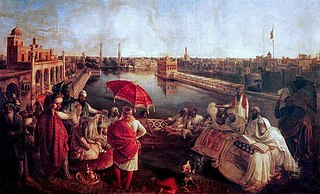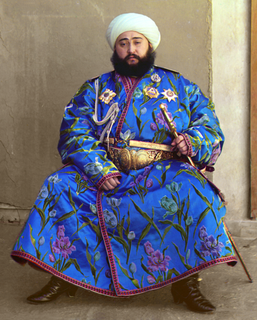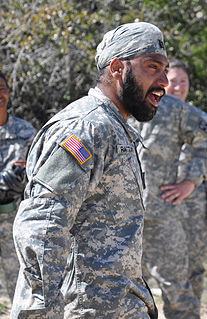Related Research Articles

Sikhs are people who adhere to Sikhism, a monotheistic religion that originated in the late 15th century in the Punjab region of the Indian subcontinent, based on the revelation of Guru Nanak. The term Sikh has its origin in the Sanskrit word śiṣya (शिष्य), meaning 'disciple' or 'student'.

A turban is a type of headwear based on cloth winding. Featuring many variations, it is worn as customary headwear by people of various cultures. Communities with prominent turban-wearing traditions can be found in the Indian subcontinent, Southeast Asia, the Arabian Peninsula, the Middle East, the Balkans, the Caucasus, Central Asia, North Africa, West Africa, East Africa, and amongst some Turkic peoples in Russia as well as Ashkenazi Jews.

In Sikhism, the Five Ks are five items that Guru Gobind Singh Ji, in 1699, commanded Khalsa Sikhs to wear at all times. They are: kesh, kangha, kara, kachera, and kirpan.
3HO , also known as Sikh Dharma of the Western Hemisphere or Sikh Dharma International, is an American organization that started in about 1970. It was founded in the West by Harbhajan Singh Khalsa, also called "Yogi Bhajan"- Its followers are primarily Americans. Its adherents are popularly referred to as the Sikh Dharma Brotherhood. While referred to as the 3HO movement, "3HO" is strictly speaking the name only of the movement's educational branch.

A dastār is an item of headwear associated with Sikhism, and is an important part of Sikh culture. The word is loaned from Persian through Punjabi. In Persian, the word dastār can refer to any kind of turban and replaced the original word for turban, dolband (دلبند), from which the English word is derived.
The Sikh Light Infantry is a light infantry regiment of the Indian Army. The regiment is the successor unit to the 23rd, 32nd and 34th Royal Sikh Pioneers of the British Indian Army. The regiment recruits from the Sikh community of Himachal Pradesh, Punjab and Haryana states of India. The versatility of the Sikh Light Infantry has seen the regiment conduct operations from conventional warfare on the Siachen Glacier, the highest battlefield in the world, to counter-terrorism. Units of the regiment have also been deployed as part of the United Nations Emergency Force. The regimental motto is "Deg Tegh Fateh", meaning "prosperity in peace and victory in war". The motto has great significance with the tenth Sikh guru, Guru Gobind Singh, with whom the Mazhabi community is very closely associated, Guru Gobind Singh named them mazhabhi as in faithful for their dedication to do good. The regiment's cap badge is a chakram or quoit, with a mounted kirpan. The insignia was designed to honour the Mazhabi community's Akali Nihang ancestry.

Sikhism is a religion originating from medieval India which was introduced into the United States during the 19th century. In 2007, there were estimated to be between 250,000 and 500,000 Sikhs living in the United States, with the largest populations living on the East and West Coasts, together with additional populations in Detroit, Chicago, Houston, Dallas, and Indianapolis. The United States also has a number of non-Punjabi converts to Sikhism.

Canadian Sikhs number roughly 500,000 people and account for roughly 1.4% of Canada's population. Canadian Sikhs are often credited for paving the path and creating the presence of Sikhism in the United States. Sikhism is a world religion with 27 million followers worldwide, with majority of their population in Punjab, India. The Legislative Assembly of Ontario and all other provinces in Canada celebrates April as Sikh Heritage Month.

The Sikh Khalsa Army, also known as Khalsa or simply Sikh Army, was the military force of the Khalsa, formed in 1598 by Guru Hargobind. It was a cavalry unit until the time of Guru Gobind Singh ji. From Maharaja Ranjit Singh on the army was modernized on Franco-British principles. It was divided in three wings: the Fauj-i-Khas (elites), Fauj-i-Ain and Fauj-i-Be Qawaid (irregulars). Due to the lifelong efforts of the Maharaja and his European officers, it gradually became a prominent fighting force of Asia. Ranjit Singh changed and improved the training and organisation of his army. He reorganized responsibility and set performance standards in logistical efficiency in troop deployment, manoeuvre, and marksmanship. He reformed the staffing to emphasize steady fire over cavalry and guerrilla warfare, improved the equipment and methods of war. The military system of Ranjit Singh combined the best of both old and new ideas. He strengthened the infantry and the artillery. He paid the members of the standing army from treasury, instead of the Mughal method of paying an army with local feudal levies.
G.B. Singh is the author of Gandhi Behind the Mask of Divinity, a biography of Mahatma Gandhi and Gandhi Under Cross Examination.

Facial hair in the military has been at various times common, prohibited, or an integral part of the uniform.

There have been Sikhs in the United States military since World War I. Sikhs and Sikh Americans have served through all subsequent wars until the present day. Since the 1980s, observant Sikhs have faced difficulty in serving due to a discontinuation of exemptions to uniform standards which previously allowed Sikhs to maintain their religiously-mandated beards and turbans while in uniform.

Religious symbolism in the United States military includes the use of religious symbols for military chaplain insignia, uniforms, emblems, flags, and chapels; symbolic gestures, actions, and words used in military rituals and ceremonies; and religious symbols or designations used in areas such as headstones and markers in national cemeteries, and military ID tags.
Sikhism was founded in Punjab in 1469 by Guru Nanak on the foundations that everyone is equal, regardless of caste, age, or gender. Both men and women are supposed to follow the Five Ks: Kesh, Kangha (comb), Kara, Kachera and Kirpan, and there was never a distinction between what a woman should be allowed to do versus a man at theological level. Men and women are treated equally in the temple (gurdwara), and everyone eats and prays side-by-side. Both men and women are meant to carry the Kirpan with them as they are responsible for their own physical protection, and should not depend on others. Sikhs are strictly against the caste system and many chose to use Kaur or Singh as a last name to push against the problematic caste system in India. There is only one god (Waheguru) in Sikhism and they are without form or gender, and everyone is equal in the eyes of God. Many Sikh women believe that this absence of assignment of code of conduct for a woman versus a man proves that their religion is historically committed to gender equality. Presently, the culture does not always follow these traditions and equality is often more true in ideals rather than daily practice. According to Kiman Kaur: "It is essential to take into account the diverse Kaur narratives in order to critically understand the violence Sikh womxn experience due to religious, ethnic, and gender minoritization through enabling more intersectional conversations."

St. Edward's School is a premier convent school located at Milsington Estate, Shimla, Himachal Pradesh, India. It is a boys-only day school. St. Edward's has been ranked among the top schools in India. It was initially affiliated to ICSE but was changed over to the Central Board of Secondary Education (CBSE) system in 2008. Today the School is managed by Simla Chandigarh Educational Society, under the Bishop of Simla Chandigarh Diocese. The school offers education from Nursery to Class XII.

Ravi Singh is a Sikh American entrepreneur, author, and the first turban wearing, US military cadet (ARMY), a conservative (Republican) candidate for Illinois State Representative politician who fought conviction of 3 felony for eight (8) years regarding US Federal counts relating to a California State, San Diego mayoral election, and fought to wear his turban even in US Federal Prison during his 120 Days incarceration. He was the founder and CEO of Electionmall Technologies, a non-partisan marketing company that offers technology products and services tailored to those running for political office, and co-branded with Microsoft the first cloud based software, Campaign Cloud invented by him. Singh became known as the first U.S. cadet to graduate from a military academy with a turban. His 1998 bid for the Illinois Legislature made him the first Asian to ever run for the position. Singh has been honored with numerous awards and recognitions including the Sikh in Media Award in 2011, and a Rising Star, a prestigious honor given in politics.

Wiccans and Pagans in the United States military have, since the close of the 20th century, experienced a gradual increase in official recognition. The Wiccan pentacle is now an approved emblem for gravestones under the Veterans Administration, achieved in 2007 following legal action regarding the grave of Wiccan soldier Patrick Stewart. In 2011, the United States Air Force Academy dedicated an $80,000 "outdoor worship center" for "Earth-based religions" such as Paganism and traditional Native American religions. As of 2015, there is no provision for official recognition of Wiccan or Pagan chaplains.
Gyani Sundar Singh Sagar, commonly known as Gyani Ji, was a Sikh scholar and social activist. He dedicated his life to various campaigns for Sikh rights to be recognised and respected in the United Kingdom. Principal among those were his fight for the turban including a seven year campaign for Sikh bus conductors in Manchester to be able to wear the turban as part of their uniform and his protest against The Motorcycle Crash Helmets Act of 1972 so Sikhs could legally be allowed to wear turbans instead of crash helmets.

Ravinder Singh Bhalla, often simply called Ravi Bhalla, is an American civil rights lawyer, politician, and the mayor of Hoboken, New Jersey. Prior to becoming mayor, he served in the city council of Hoboken, New Jersey, since 2009. On November 7, 2017, he was elected New Jersey's first Sikh mayor, as well as the first elected mayor in the United States who is a Sikh and wears a turban.
References
- 1 2 "Singh v. Carter". Becket. Retrieved 2020-06-16.
- ↑ "Sikh-American Military Officer Files Lawsuit to Serve with Turban, Beard". NBC News. Retrieved 2020-06-16.
- 1 2 Philipps, Dave (2016-04-01). "Sikh Captain Says Keeping Beard and Turban Lets Him Serve U.S. and Faith". The New York Times. ISSN 0362-4331 . Retrieved 2020-06-16.
- 1 2 "A Sikh soldier's holy fight – Story of Captain Simratpal Singh". SBS Your Language. Retrieved 2020-06-16.
- 1 2 3 "U.S. Army allows first Sikh-American to serve with turban, beard". The Washington Times. Retrieved 2020-06-16.
- ↑ "US court favours Sikh religious rights in armed forces". Hindustan Times. 2016-03-04. Retrieved 2020-06-16.
- ↑ "Sikh captain sues US army over 'targeted' grooming tests". Hindustan Times. 2016-03-01. Retrieved 2020-06-16.